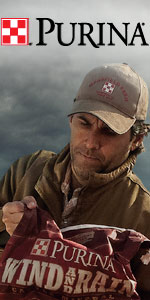Tour
Alberda Angus | Armstrong Angus Ranch | Circle L | GaLor Angus | Heide Ranch
Hyline Angus Ranch | KG Ranch | Kimm Angus | Leachman Angus Ranch
MSU Animal Bioscience Building | PAPA Livestock | Reyher Embryonics | Sitz Angus Ranch
South Boulder Angus | Split Diamond Ranch | Thousand Hills Angus | Timber Line Ranch
Van Dyke Angus Ranch | Westra Angus | Wheeler Mountain Ranch | Yadon Angus Ranch
Tour Stop: KG Ranch, Three Forks
Paul and Kaye Doddridge
Established in 1978, KG ranch is headquartered south of Three Forks, Mont., along the Jefferson River. What started as a small 300-acre parcel has matured into one of the largest registered Angus herds in the United States.
KG Ranch is the pride of owners Paul and Kaye Doddridge. The ranch is comprised of about 30,000 acres, ranging in elevation from 4,300 feet (ft.) to 7,500 ft. Greg Strohecker has managed the ranch for the past 30 years, building it into what it is today.
A horseback outfit for sure, hardly a day goes by that the horses aren't wrangled in for the cowboys to do their work. The KG Ranch crew has a passion for ranching and Angus cows.
Visitors to KG often comment on the working facilities. The ranch has an outstanding set of pens to work with on a daily basis, easing cattle processing for both the cattle and the crew. The buildings, working facilities, feedlots and homes have all been built by Greg and the KG crew.
In 2006 expansion was necessary, and a weaning bull development facility was built at KG Ranch's Sappington division. Seven large pens designed with the feed at the top and water at the bottom of a slight hill in between ensure young bulls get a lot of exercise during development.
Spring 2010 will see 1,000 calves born to the KG cow herd from KG Ranch-owned bulls such as Connealy Contrast, Rainmaker 9723, Alliance 7544 and Sitz Wisdom.
The KG ranch annual production sale hosted the first Friday in December is the highlight of the year. The sale features 200 coming 2-year-old bulls and 400 synchronized and artificially inseminated (AI) commercial bred heifers. KG also sells bulls by private treaty each spring. Quality Angus cattle and repeat customers never go out of style at the KG ranch.
Heide Angus (guest at KG Ranch)
John and Nancy Heide
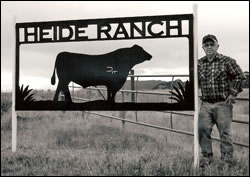
John Heide
John and Nancy Heide welcome you to Heide Ranch and the South Montana Angus Tour.
Heide Ranch was established in 1956 and is located between Butte and Helena in the North Boulder Valley. The registered herd began in 1983 when daughter Paula purchased a 4-H heifer from Harry Morris at Divide, Mont.
The herd has grown to 100 cows plus the commercial herd. All of the registered cows are artificially inseminated for one cycle to top sires in the industry. The Heides keep the top 50% of the bull calf crop. The bulls are wintered at the ranch with a bull grower pellet along with free-choice grass hay. They are then offered for sale by private treaty after Feb. 1. The Heides also sell some heifer calves and bred heifers.
This year's reference sires include HA Image Maker 0415, B/R New Frontier 095, Bon-View New Design 1407, HSAF Bando 1961, and Connealy Packer 547. Cleanup bulls are sons of Mytty in Focus and 55 Objective.
The Heides say they are fortunate to have the same employee with them for the past 20 years. Steve and his family live in Boulder, where he teaches science at Jefferson High School. He works in the summer and whenever needed throughout the year.
Timber Line Ranch (guest at KG Ranch)
Jason, Jane, Catherine, and Krista Callantine
Timber Line Ranch has been producing Angus cattle since 1948 and has registered cows since 1954. The ranch is located 23 miles north of Bozeman at the foot of Flathead Pass in the Bridger Mountains. The beauty of the Gallatin Valley lured Jason Callantine's grandfather's brother, Felix Callantine, to homestead the ranch in 1882 after working the railroad grade to the Northern Pacific Railroad. Jason is the fourth generation to ranch here, and he does so with his wife, Jane, and daughters Catherine, 16, and Krista, 12. Catherine is currently Montana Angus Queen and Krista is Montana Angus Princess.
Although the operation has endured some changes, the goals of the cow herd have remained the same. The Callantines will not tolerate excess calving problems; the cows must have adequate milk and above-average growth on a moderate frame. The Callantines expect them to breed back and maintain their condition on a moderate ration.
Today the ranch maintains approximately 230 mother cows and sells commercial and registered bulls and heifers by private treaty.
With the challenges of ranching in an ever-increasing urban environment, this is still "God's Country," say the Callantines, welcoming tour participants to South Montana.
Alberda Angus (guest at KG Ranch)
Jon and Norma Alberda
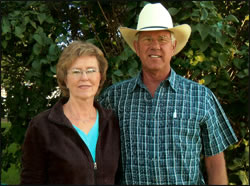
Jon and Norma Alberda
Jon Alberda's father, Joe, purchased the ranch in 1952. He; Jon; and his two brothers, George and Doug, ran the ranch until three years ago. Jon and Norma are now operating the ranch.
Jon and Norma raised three children. Son Dan and his wife, Shara-lyn, have three children: Olivia, Travis and Sonja. Dan works at the Stillwater Mine in Columbus, Mont. Daughter Shannon has three children: Ashley, Kelsey and Cole. Shannon helps on the ranch. Son Joe died in 1998.
"Faith in God and family are the biggest parts of our lives," the Alberdas note.
Jon and Norma say they are privileged to live in the country and work with the cattle and the people in the Angus business. They have about 150 mother cows and sell cattle by private treaty.
The Alberdas have a simple idea about breeding cattle: "First they have to look the part. They have to be real deep, lots of rib and easy-fleshing. If we have a good cow, then she'll give us a good bull calf."
Home to Alberda Traveler 416, his bloodline continues in the herd.
Circle L Angus (guest at KG Ranch)
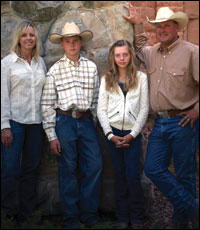
The Lamey Family
Cory and Kari Lamey of Circle L Angus welcome you to the South Montana Angus Tour. While the tour will not reach into their Big Hole Valley, Circle L will display cattle at KG Ranch.
In the late 1980s the Lameys made their first registered Angus selections, adding to their existing commercial herd. By 2001, they selected top donor prospects from proven cow families Sinclair Lady 4465, Sitz Everelda Entense 1905, Stevenson Enchantress 16A, BT Nellie 286K, Leachman Lass 5008 and Davis Blackbird 558H. The daughters and granddaughters of these legendary females are making an impact in the herd, thus establishing Circle L Angus.
As third-generation ranchers, the Lameys are in touch with the demands and needs of the business and take great satisfaction in producing quality seedstock. In 2008, they hosted a female sale, and they will host their third annual bull sale in Dillon, Mont., this spring. They plan to offer a select group of females in the female sale being held in conjunction with the tour.
Alberda Angus | Armstrong Angus Ranch | Circle L | GaLor Angus | Heide Ranch
Hyline Angus Ranch | KG Ranch | Kimm Angus | Leachman Angus Ranch
MSU Animal Bioscience Building | PAPA Livestock | Reyher Embryonics | Sitz Angus Ranch
South Boulder Angus | Split Diamond Ranch | Thousand Hills Angus | Timber Line Ranch
Van Dyke Angus Ranch | Westra Angus | Wheeler Mountain Ranch | Yadon Angus Ranch
Tour stop: Hyline Angus Ranch, Bozeman
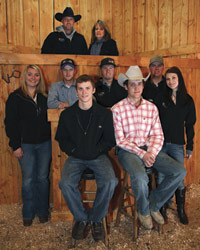
The Van Dykes
Hyline Angus Ranch was started in 1959 when Ray Van Dyke purchased 10 registered heifers from Harrer's Valley Grove Angus. From the beginning, the basic principles have been to have sound, functional cattle that work for commercial cattlemen.
The Hyline herd got national recognition by bulls performing well in performance test stations. The cow herd is managed the same as a commercial herd — on grass all summer without creep.
"By doing this we have been able to find the true great cows year after year," Ben Van Dyke says.
Through the years the Van Dykes have produced several breed-leading sires, such as Hyline Travel Agent, who sold for $180,000 in Hyline's 1992 sale; Hyline SVF Rito 1116, who also sold in the 1992 sale to EE Ranches and went on to produce many great females still in the herd today. Through the years the ranch has produced many great females — like Pride of Hyline 8040 and Hyline Pride Lucy 8038 — who left a lasting impression on the Angus breed.
In 1998, Hyline Right Time 338, an all-around performance bull used by many breeders, was born on the ranch. He has produced many sons that have been widely accepted by breeders across the country. 338 daughters are known for good udders, sound feet and legs, and producing calves year after year.
Tour Stop: Armstrong Angus Ranch, Cardwell
George Jr. and Fay Armstrong, Chad and Trista Armstrong
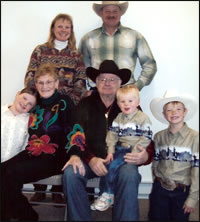
The Armstrongs
The Armstrongs represent the third and fourth generations to ranch in this valley. The registered herd began in 1974 with three heifers from George's uncles. In 1976, five heifers were bought from Bob Sitz, and later five more. Cows have also been added from the Glaus, Younkin and Van Dyke herds.
The Armstrongs now manage 250 registered and 100 commercial Angus cows with a few Aubrac cows. The cows mainly summer in the mountains and typically graze until they start calving in late January. The Armstrongs believe input costs must remain low in order to survive in the commercial cattle industry. They want low-maintenance, fertile cattle that produce into their teens. The program is based on calving ease and fertility. Cows must have good udder structure and small teats. Bulls must be masculine, have tight sheaths and be assertive breeders.
Bulls that have worked well for the Armstrongs include: Biffles Emulous, Juanada Lad of RR, Sitz Marshal Pride, Emulation 31, Rito 149, QAS Traveler, Super Bank, Paramout Ambush 2172, Traveler 6807, JLB Exacto, Rito 6I6 and two of their own bulls (VDAR Traveler 455 and AAR Extra 814). This year's bull calves are mainly sired by BC Mid Emblazon 854E 702, SAV Final Answer, Jipsy Earl, AAR Extra 814, AAR Bushwacker 417, Sitz Alliance 7544, SS Objective T510 0T26 and VDAR Traveler 455.
The Armstrongs believe everything on earth belongs to our Lord and Savior, Jesus Christ, and that they are here to manage it for his glory. They are breeding cattle with the intent of helping commercial cattlemen remain in a profitable business. Their goal is to assist cattlemen in finding the cattle that suit them best. If they don't have what a buyer is looking for, they will try to help them find it elsewhere.
Tour Stop: Wheeler Mountain Ranch, Whitehall
Ron and Kate Van Dyke, David Van Dyke, Philip and Jacquie Hofer, and Brett and Stacy Ellision
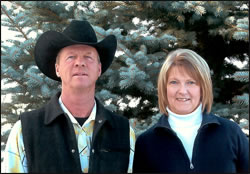
Ron and Kate Van Dyke
Wheeler Mountain Ranch is a family-owned and -operated ranch overseen by Ron and Kate Van Dyke, along with son David, daughters Stacy and Jacquie, and sons-in-law Brett and Philip, who are all integral parts of the operation.
The Van Dykes have a long history in the Angus business, growing up with Hyline Angus. Ron's first Angus heifer was an eighth-grade graduation gift from his father, Ray Van Dyke, in 1969. Ron's herd grew from there, and his family set out on its own in 1988 to continue breeding the high-performing cattle they grew up with.
The operation stocks 700 mother cows on more than 40,000 acres, which means big short-grass sagebrush country on up to high-mountain meadows at 7,500 feet. Environment dictates cattle type. The Van Dykes require a mature cow to wean at least 50% of her weight. Moderation is key, as cows that get too big have a harder time weaning 50%, and cattle that are too small usually lack the performance required. Environment serves as the ranch's best sorting stick, and their commercial customers appreciate the fact that they test their cattle in the real world.
With this selection pressure, it stands to reason that bulls raised in the program would do well in the program. McBee WMR Super X 745 and WMR Dateline 210 are home-raised bulls that have left outstanding daughters. On the tour stop, you will see sire groups from proven sires like SRA 2418 of RR 303, Leachman Right Time 338-5605 and WMR Packer 1036, as well as the very first calves by Apex Windy 078 and WMR Timeless 458, their high-selling bull to Harrison Land and Cattle and a featured young sire at Accelerated Genetics.
Bulls are sold in the ranch's annual production sale hosted the fourth Tuesday of March. Cows are sold by private treaty.
South Boulder Angus (guest at Wheeler Mountain Ranch)
Dennis and Valerie Houtzel, Ryan Houtzel and Royce Verploegen
Dennis and Val Houtzel were living in Illinois when they purchased their first registered Angus heifers from Bill Engelbrecht of Henry, Ill. Their family and their cows moved to southwest Montana in May 1997. They purchased their ranch, South Boulder Angus Ranch of Cardwell, Mont., in August 1999. With no useable structures available, Dennis and son Ryan started building — first a home, then the barn, then the corrals.
In the meantime, they slowly grew their herd by retaining heifers. Bulls were marketed through the South Montana Angus Association Bull Sale. The Houtzels used AI on cows and heifers and bought the best bulls they could afford to buy. In 2006, they increased their herd by buying Gary and Ann Lower's registered cow herd.
The Houtzels currently manage about 70 registered cows and 20 commercial cows. Ryan and his fiancé, Royce Verploegen, help out as much as they can. Ryan takes time off from his job and helps with the haying. Royce, who works at Milk River Genetics, does the ranch's embryo transfer work.
The Houtzels believe in a female that is structurally sound, with good feet and legs to travel. She must have depth of body for capacity to hold plenty of feed, not only to take care of herself, but to convert that feed to milk and put it through an excellent udder so she can wean a calf that weighs at least half as much as she does. When choosing bulls to sell as yearlings or bulls to purchase or use via AI, the Houtzels look for length of body, depth of body for capacity, and structural soundness in feet and legs. They don't have any particular paternal bloodlines but are heavily influenced by the Forever Lady maternal lines. Bulls and heifers are grown on a high-forage, low-grain diet and are sold private treaty every spring.
Tour Stop: Split Diamond Ranch, Whitehall
Steve and Linda Buckner, Hans and Diana Buckner
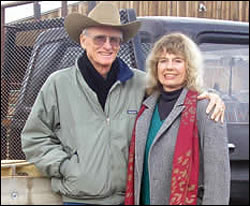
Steve and Linda Buckner
Split Diamond Ranch originated in the higher mountains south of Wise River, Mont., in the 1970s. The Buckners moved to Whitehall in 1991 to increase the herd from 110 pairs to the current 450 registered Angus females. The Wise River ranch is still used today as summer pasture for bred replacement heifers.
Steve and Linda Buckner and Hans and Diana Buckner calve to be done in a 45-day period, beginning mid-January and lasting through February. Cows bred to calve in March and April are marketed in the fall. Maternally superior females with nursing ratios of 103% or higher and 100 replacement heifers are AIed. The balance of the cows are used as recipient cows for the embryo program, allowing the Buckners to AI more than 200 cows and implant 120 embryos per year.
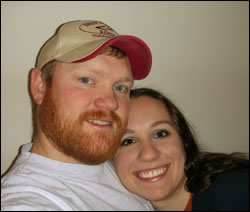
Hans and Diana Buckner
The Buckners use maternally superior sires with curve-bending genetics to promote easier calving and higher weaning weights. The herd is heavily influenced by N-Bar Emulation EXT, Sitz Traveler 8180, Traveler 124, Right Time, Band 105, and Bando 155. More recent use of In Focus, Image Maker, Connealy Lead On, SAV Final Answer 0035 and Justice N013 has allowed the Buckners to continue to produce efficient, long-lasting females and bulls.
Cows with bull calves summer in the Big Hole Valley on high-altitude grass, which promotes muscle growth and development. The bulls are weaned at the end of August and put on green grass pasture for 40 days until they begin a 110-day performance test on a high-roughage ration targeted for gains of 3 pounds per day prior to sale. Bulls and replacement heifers are scanned by ultrasound for carcass merit as yearlings. Calves are tested for bovine viral diarrhea at birth, along with any new arrivals to the ranch.
The Buckners will sell 100 yearling Angus bulls in their March spring bull sale. Females are marketed through their bull sale, the Northern International Livestock Exposition (NILE) in Billings, National Western Foundation Female Sale in Denver and by private treaty.
The Buckners say they are very fortunate and proud to have the crew of Nacho Rodrigues, Chuck Walker and their families working with them.
Tour Stop: Van Dyke Angus Ranch, Manhattan
Keith Van Dyke, Lee Van Dyke, Clarence Van Dyke
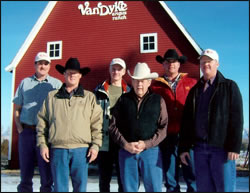
Back Row: Paul Feddes, Nathan Feddes,
Travis Kindred;
Front Row: Keith, Clarence
and Lee Van Dyke
Van Dyke Angus was started in 1960 by Clarence Van Dyke and is now run by Keith and Lee Van Dyke with the help of Paul and Nathan Feddes and Travis Kindred. The Angus herd consists of 400 registered cows, split between two different locations: one, east of Manhattan, Mont.; the other, the old home place between Bozeman and Churchill, Mont.
The Van Dykes host an annual bull sale the last Thursday of February in which they sell 175 bulls. They sell 150 females by private treaty in the fall. They also farm 1,500 acres of irrigated and dry land.
The philosophy at Van Dyke Angus Ranch is to breed profitable cattle for the commercial industry.
"The most important decisions that we make here are the cattle we choose to keep in our herd," Keith says. Fertility is a priority. If any cow does not breed within a 42-day window, she is culled regardless of who she is or what she has done. Other necessities are structural soundness, mothering ability, longevity, ease of fleshing, docile temperament and udder quality.
Yadon Angus Ranch (guest at Van Dyke Angus Ranch)
Bob and Sally Yadon
Bob and Sally Yadon of Yadon Angus Ranch note that the Montana Angus Tour was last held in South Montana in 2003. In the last seven years, their family has grown. Morgan and Cassie joined the Yadon tribe in 2005. They now have four grandchildren.
In 1983, Bob and Sally came back to the family farm where Bob grew up. It continues to be a family-run operation. Bob and Sally and their three dogs handle most of the day-to-day responsibilities, with their children throwing in and helping when they can.
The Yadons purchased their first 10 registered cows from Dave Hinman in 1986. The herd foundation is built on Rito and Band 105 genetics. They strive to breed top-producing females, demanding that they have good udders and be highly maternal, with lots of volume. Many of the 2010 AI calves will be from top-performing HA Image Maker 0415 and OCC Emblazon 854E sons the Yadons have sold to registered breeders. They used OCC Emblazon 854E once again in their AI program and will have some Emblazon ET calves out of the YA Bluebird Lass 960 cow along with some Quantum 3330 ET calves out of the old YA Highroller Lass 2002 cow.
The Yadons raise grass-alfalfa mix hay and certified seed. The Yadons say they have great water rights and irrigate with wheel lines, hand lines and flood irrigation. The ranch is 340 acres. They can pasture 75 pairs on this place and rent another 160 acres that allows them to stock 100 cows from year to year. They retain 25 replacements a year, selling the remainder by private treaty and consigning top heifers to the Montana Supreme Sale from time to time.
The Yadons retain only the top-performing calves out of cows with good records. The rest make nice steers. Bull calf pairs have been summered on the same unimproved pasture for the last 24 years. Weaning weights have increased by 200 pounds over time. The bulls are marketed private treaty and through the South Montana Angus Sale.
"We love the land, the cattle, the life," Bob and Sally emphasize.
Kimm Angus (guest at Van Dyke Angus Ranch)
Tom and Denise Kimm, Riley Kimm, Harvey and Gretchen Kimm
Kimm Angus is a family-run ranch located 14 miles south of Manhattan, Mont. You are welcomed to the ranch by Tom and Denise, Riley, and Harvey and Gretchen.
In 1989, the Kimms purchased their first registered Angus females from Van Dyke Angus. Then, in 1991, they selected a top heifer from McCumber Angus Ranch in North Dakota. With these foundation cows and the use of proven AI sires and ET, the Kimms have expanded their herd to 125 registered cows.
They strive to produce cattle with strong maternal traits that have deep capacity, good fleshing ability and they must breed back early.
The Kimms retain the top 50% of the heifer calves as replacements. They castrate 50% of the bull calves to ensure that only the top end will be offered to customers. The Kimms market their bulls through the South Montana Angus Association Bull Test and Sale, which is the third Saturday in March at the Montana Livestock Auction in Ramsey, Mont. The remaining bulls and some of the females are sold private treaty.
PAPA Livestock (guest at Van Dyke Angus Ranch)
Carol Davis, B.J. Playle
PAPA Ranch welcomes tour participants to the Gallatin Valley. PAPA Ranch was founded by Carol Davis and her late husband, Dale H. Davis, in 1984. Dale's interest in registered Angus began a number of years before then. A highlight of these formative years was the consignment of a group of young sires by Rito N Bar to the 1967-1968 Stanford Production Index Center test. When the test was complete RR Rito 707 was the high-gaining and high-yearling-weight bull, as well as the high seller. "707" was used quite extensively in many leading purebred and commercial performance herds.
After the death of Dale's first wife, he sold Rollin' Rock Angus to his son, Bill Davis, but Dale's love for the cattle industry and the Angus breed was in his blood. Thus, the birth of PAPA Ranch, PAPA standing for Practical And Predictable Angus.
Practical cattle, Carol says, are cattle that will make customers the most net profit. It means live, vigorous calves born with little or no assistance and raised on their mama's milk, without creep and a lot of fuss. It means heifers that calve as 2-year-olds are good mothers, raise a heavy calf at weaning and breed back on schedule under ordinary range conditions. It means cows with good dispositions that are structurally sound throughout their lifetime, with udders and teats that stay sound.
Predictable means cattle that will breed like they look and like their expected progeny differences or individual performance records say they should, accomplished by using a consistent criteria selecting for economically important traits on an accurate within-herd comparison basis, year after year and generation after generation. To add predictability, PAPA Ranch linebreeds to a common ancestor that has proven him- or herself in the program to be a consistent producer of all the economically important traits in the proper balance — not spectacular in some traits and lacking in others.
In the beginning Dale and Carol operated using two prefixes, DHD or PAPA Ranch. DHD and PAPA Ranch have linebred top pathfinder sires, including DHD Traveler 6807, PAPA Universe 515, PAPA Durabull 9805, PAPA Forte 1921, PAPA Equator 2928, and PAPA Rito Intense 6844. In the PAPA Ranch Performance Foundation Female Sale in 1998, PAPA sold 20 Pathfinder dams.
The rebirth of PAPA Ranch Livestock LLC began in 2005. Grandson B.J. Playle and Carol are rebuilding with PAPA genetics sold to and now purchased from Sinclair Cattle Co. and Beartooth Angus. They have also accessed top PAPA genetics by AIing and implanting embryos preserved from eight PAPA Pathfinder dams. They are determined to continue the pursuit of the same objectives set forth in 1984 in the birth of PAPA Ranch, Practical and Predicable Angus that will make customers the most net profit.
Westra Angus (guest at Van Dyke Angus Ranch)
Bernie Westra, Kurt Westra, Lisa Russell
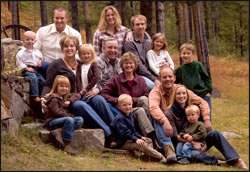
The Westra family
Westra Angus is a small ranch located in the middle of the Gallatin Valley, 6 miles west of Belgrade. The operation had its beginning in 1973 when owner Bernie Westra purchased his first commercial black Angus. For the next 20 years he built up his commercial herd by keeping replacement heifers. Bernie always enjoyed looking for a great bull to better the herd and increase those weaning weights.
In 1995, Westra Angus changed its focus from commercial Angus to registered Angus with the purchase of 16 registered Angus cows from friend Arnold Blanksma.
Today Westra Angus consists of all registered Angus cows and involves Bernie, son Kurt Westra and daughter Lisa Russell. The herd goes back to Rito 2100, VDAR 315, VDAR Lucy's Boy and VDAR Right Time.
The focus of the Westra breeding program is very selective. They strive for low birth weights, calving ease, growth and fleshing ability, udder quality, mild dispositions and, most of all, fertility. They select sires that are positive in scrotal circumference, ribeye area and percent retail product. Westra Angus aims to produce cattle that are structurally sound with good dispositions.
Calves are born in January and early February without assistance. They are summered on mountain pasture with no creep. Westra Angus enters bulls in the Midland and Southwest Montana bull tests. Their yearling bulls sell at the Southwest Montana Bull Sale in Ramsey, Mont., the third Saturday in March and by private treaty at the ranch.
Alberda Angus | Armstrong Angus Ranch | Circle L | GaLor Angus | Heide Ranch
Hyline Angus Ranch | KG Ranch | Kimm Angus | Leachman Angus Ranch
MSU Animal Bioscience Building | PAPA Livestock | Reyher Embryonics | Sitz Angus Ranch
South Boulder Angus | Split Diamond Ranch | Thousand Hills Angus | Timber Line Ranch
Van Dyke Angus Ranch | Westra Angus | Wheeler Mountain Ranch | Yadon Angus Ranch
Tour Stop: Montana State University Animal Bioscience Building, Bozeman
The state-of-the-art Montana State University (MSU) Animal Bioscience Building will allow the growth and expansion of education and research programs that better meet current and future needs of agriculture and the livestock industry. Together with the U.S. Department of Agriculture-Agricultural Research Service (USDA-ARS) Animal Bioscience Research Facility, the Animal Bioscience Building is an integral part of the long-range plan of MSU and the College of Agriculture/Montana Agriculture Experiment Station to increase the competitiveness and profitability of agriculture, especially the livestock industry; prepare the agriculture community for the 21st century; and capture added value of regional and national resources in a global economy.
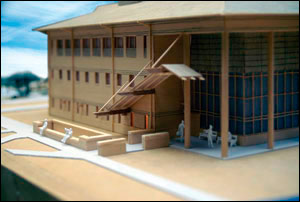
Montana State University Animal Biosience Building
Photos by Kelly Gorham, Montana State University
(Place mouse on picture for different view)
The complex will provide opportunities to promote wise multiple-use stewardship of Montana's natural resources and celebrate Montana's rich heritage in livestock and natural resources. The U.S. Congressional delegation continues to fully support the broader project by keeping the USDA-ARS Animal Bioscience Research Facility at the forefront and securing funding for it every year.
The $15.7-million, 40,000-square-foot teaching facility will house the Department of Animal and Range Sciences. It includes classrooms, teaching laboratories, technology transfer rooms, research facilities and faculty and staff offices. Construction began in August 2008. Completion is expected by fall 2010. The outreach capabilities of the facility will ensure that both students and producers are kept abreast of animal and range research conducted at MSU, including the functional genetics research occurring in the USDA-ARS facility.
Of the $15.7 million, half of the funds have been raised privately from farmers, ranchers, agribusinesses, and other supporters across the state and throughout the country. The range-livestock community has been very supportive of the project with large donations pledged by livestock-related producer organizations in the state, several banks, a few major companies, and multiple individuals and ranches. The Ranchers Circle recognizes ranches, businesses and individuals that commit $10,000 or more to the Animal Bioscience Building. There are currently 141 members of the Ranchers Circle, all of whom will be recognized on a donor wall in the building for their visionary generosity.
Tour Stop: Leachman Angus Ranch, Toston
Eric, Marlo, Abby and Wade LeachmanLeachman Angus Ranch has moved to a new location in the Crow Creek Valley near Townsend, Mont. Les and Ruth, along with Jay and Cheryl, started the ranch near Bozeman in 1972 after the family sold their interests in Ankony Angus. In 2004, Jay decided to disperse and retire from the business. Eric and Marlo retained cattle from the original Leachman Angus herd.
Today, the ranch is operated by the third and fourth generations — Eric; his wife, Marlo; and their children, Abby and Wade. Leachman Angus Ranch currently manages about 150 mature cows along with 50 replacement heifers. The ranch is still growing in cow numbers by retaining more heifers and through ET.
The Leachmans start calving 2-year-olds around Jan. 20, with the mature cows following Feb 1. The cows are wintered on alfalfa-grass hay and barley straw. The Leachmans employ an extensive AI program by synchronizing the yearling heifers and breeding the cows off of natural heats for about 21-25 days. Heifer calves and yearling heifers go to a pasture lease in the hills near Three Forks, Mont. Bull calves stay home on irrigated pasture through the summer months. The calves are weaned Oct. 1, with the bull calves remaining in a feedlot environment and heifer calves turned back on pasture until Jan. 1.
Bulls are sold private treaty beginning Feb. 1. The Leachmans currently sell 50 bulls with hopes to sell 75-100 within the next couple of years. Females are sold private treaty or consigned to the Montana Supreme Sale in Columbus, Mont., in December.
The cattle you will see on the tour are a cross section of the herd and represent many years of selection and culling for traits that will make a positive contribution to the beef industry.
"We feel fortunate to being a part of this great breed of cattle for over 30 years," say Eric and Marlo.
Thousand Hills Angus (guest at Leachman Angus Ranch)
Rick, Halane, Kyle and Andy Van Dyken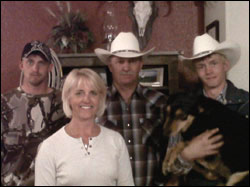
From left: Rick, Halane, Kyle and Andy Van Dyken
Thousand Hills Angus is a family-run operation. The crew consists of Rick Van Dyken and his wife, Halane. Halane serves as secretary for the South Montana Angus Association and, says Rick, is the glue that holds the outfit together. Sons Kyle and Andy provide the only additional labor for the operation. With their hard work and determination, the Van Dykens have been able to keep things headed in the right general direction. Daughter Heidi graduated from Northwestern College in Minneapolis this spring, married Jason Kool in July and is living in Wisconsin while he finishes his schooling.
The Van Dykens started in the cattle business growing up on the family farm near Belgrade, raising commercial cattle. They purchased their first Angus heifers under the name of Riverfront Angus in 1981 from Van Dyke Angus and added heifers the following year from Hyline Angus. From this base, they built their herd using AI and selecting bulls with an emphasis on maternal traits.
"It is very easy to chase after the latest fad or trend," Rick says, "but the cow is what keeps you in business. She must convert grass to pounds of beef, and raise a quality calf every year. We do not tolerate cows with poor udders or bad dispositions. It is our belief that the cow should work for you and not you for the cow."
In 2006, due to the loss of part of their leased land in the Gallatin Valley, the Van Dykens sold their land there and moved to the Toston area, which is between Three Forks and Townsend, Mont. When they moved to the new place, they changed the name of their operation to Thousand Hills. This comes from Psalm 50:10, which refers to God owning the cattle on a thousand hills.
"It is our belief that everything we have has been given to us to use to the best of our ability while we are on this earth," Rick says. "Nothing we have is truly ours."
The new place is 900 irrigated acres of hay and small grain. They still lease 430 acres of irrigated and dryland crop, with 480 acres of dryland pasture south of Manhattan. They rent pasture in the Elkhorn Mountains. As a testament to the versatility of the Angus cow, the pasture they used to lease in the Gallatin Valley could be stocked nearly a pair to the acre. The Elkhorn pasture is a pair per 40 acres. Weaning weights have not declined, and the cows cover ground impressively.
GaLor Angus (guest at Leachman Angus Ranch)
Gail and Lorrie Vennes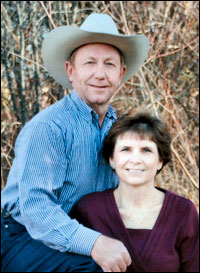
Gail and Lorrie Vennes
GaLor Angus is owned by Gail and Lorrie Vennes, Townsend, Mont. Gail and Lorrie have been in the Angus business for more than 34 years, when Gail started as an employee of Jolly Roger Angus, Belt, Mont. They moved to Townsend in 1994 when Gail became ranch manager of North Fork Angus.
In 2000, they purchased their own place for cattle and began a donor management business — GaLor Genetics Inc. They work with all breeds of registered cattle, but Angus is the most prevalent.
Gail and Lorrie manage 30-40 head of mother cows. All the females are AIed to bulls that meet the balanced traits for maximizing the production of the cows. They select only the top end of the calf crop for bulls they sell in the South Montana Angus Sale every March at Ramsey, Mont. The remaining bull calves are castrated and sold as steers. The females are kept and bred for replacements or sold as bred heifers in the fall. The Vennes also utilize some females as recipient cows for their own ET.
Reyher Embryonics (guest at Leachman Angus Ranch)
Mark and Jeanne Reyher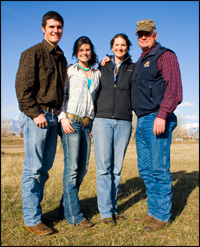
The Reyher Family
Mark and Jeanne Reyher established Reyher Embryonics in 1987 to meet the growing demands of the ET industry in Montana. Starting with a leased ranch in the Springhill area, and later moving to their Belgrade location, Mark built the entire current facility in 1993.
Today they operate the business with the expertise of Marlo and Eric Leachman of Montana Donors, who manage the donor cows at their ranch in Toston. With spacious pens, pasture and incomparable care and attention, Marlo super-stimulates and AIs all the donor cows. Mark does all the lab work and manages the business. Jeanne flushes, freezes and transfers the embryos. Seasonal help, along with their children — Sierra, a junior at Montana State, and Austin, a senior at Belgrade High — round out the Reyher Embryonics crew.
With Reyher Embryonics’ calf-back program now in its 22nd year, recipient herd owners across the state provide excellent cows and management for raising valuable Angus genetics. Providing ET services in the clinic, on the ranch and with RHO's, Reyher Embryonics has helped produce some of the greatest genetic contributions from Montana. Mark and Jeanne thank you for visiting and invite you to enjoy the Montana Angus Tour.
Tour Stop: Sitz Angus Ranch, Harrison
Bob Sitz, Jim and Tammi SitzSitz Angus Ranch of Harrison and Dillon, Mont., is a registered and commercial Angus operation that has a tremendous history and tradition in the Angus breed. 2010 marks the 87th continuous year of producing registered Angus cattle. The herd was started in 1923 by Will and Frieda Sitz in Nebraska and was later relocated to Harrison, Mont., in 1959 by Bob Sr. and Donna Sitz. They continued the development and tradition of the "Sitz Program." In 1997, the Sitz operation expanded its base with the addition of the Dillon ranch. Sitz Angus is owned and managed by Bob and Jim and Tammi Sitz.
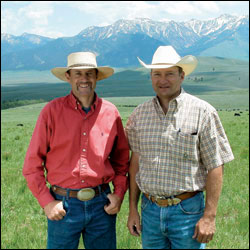
Bob and Jim Sitz
Sitz Angus has become recognized as one of the top sources of Angus genetics. With well over 1,400 registrations, it is consistently among the top in registrations recorded annually at the American Angus Association.
The Sitz program markets more than 900 bulls with two sales: the December sale at the Harrison location, which markets coming 2-year-old bulls and commercial bred heifers, and a spring sale in Dillon, which features yearling bulls and fall yearling bulls.
Throughout its history, a major emphasis of the Sitz program has been "the mother cow." Sitz females and their progeny have influenced many operations across the United States and some foreign countries. Every tool available has been utilized to enhance the productivity and quality of the Sitz female, which is considered the basis of the program. The Sitz philosophy is that of providing Angus seedstock that will enhance their customers' programs as well as their own.
AI, ET, genetic trait testing, ultrasound, DNA, genomic-enhanced EPDs and pulmonary arterial pressure (PAP)-testing are just a few of the management tools utilized to provide customers with up-to-date information. The success of these combined management practices is evidenced by the results of the annual Sitz bull sales. Sitz sires can be found in nearly every semen sale book and AI stud across America.
The Sitz families are active in community and industry organizations.
Both Bob and Jim have held positions on local, county and state organizations. Jim is serving on the Board of Directors for the American Angus Association, while Bob serves on the board of the Montana Angus Association.
Alberda Angus | Armstrong Angus Ranch | Circle L | GaLor Angus | Heide Ranch
Hyline Angus Ranch | KG Ranch | Kimm Angus | Leachman Angus Ranch
MSU Animal Bioscience Building | PAPA Livestock | Reyher Embryonics | Sitz Angus Ranch
South Boulder Angus | Split Diamond Ranch | Thousand Hills Angus | Timber Line Ranch
Van Dyke Angus Ranch | Westra Angus | Wheeler Mountain Ranch | Yadon Angus Ranch

